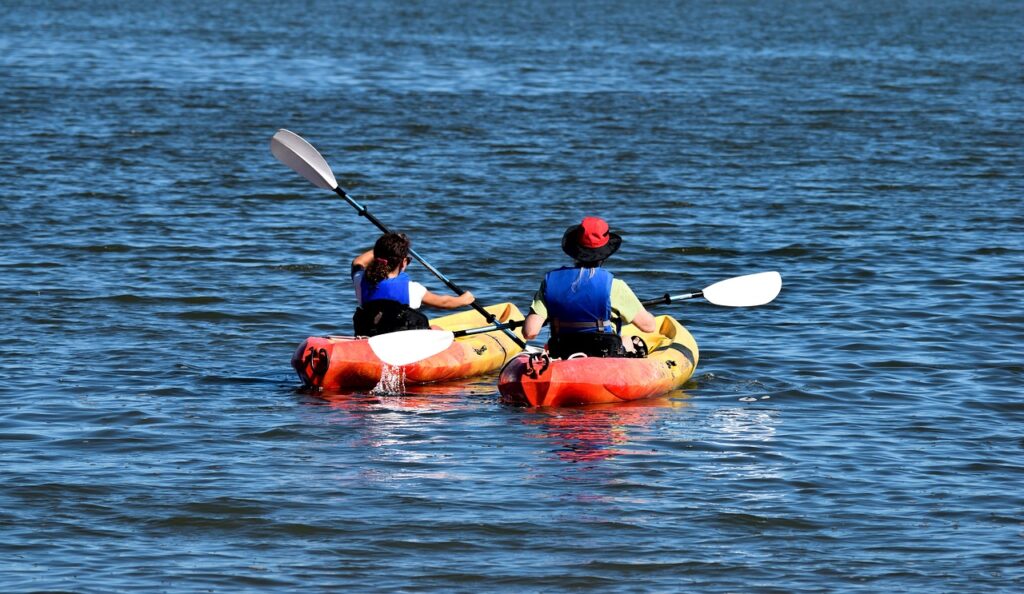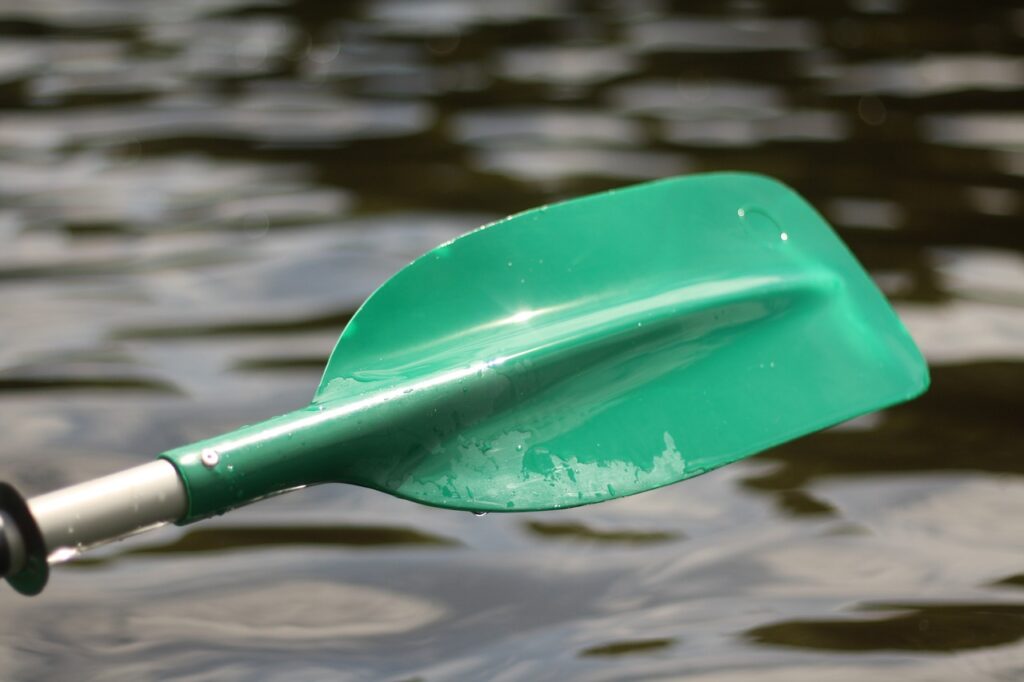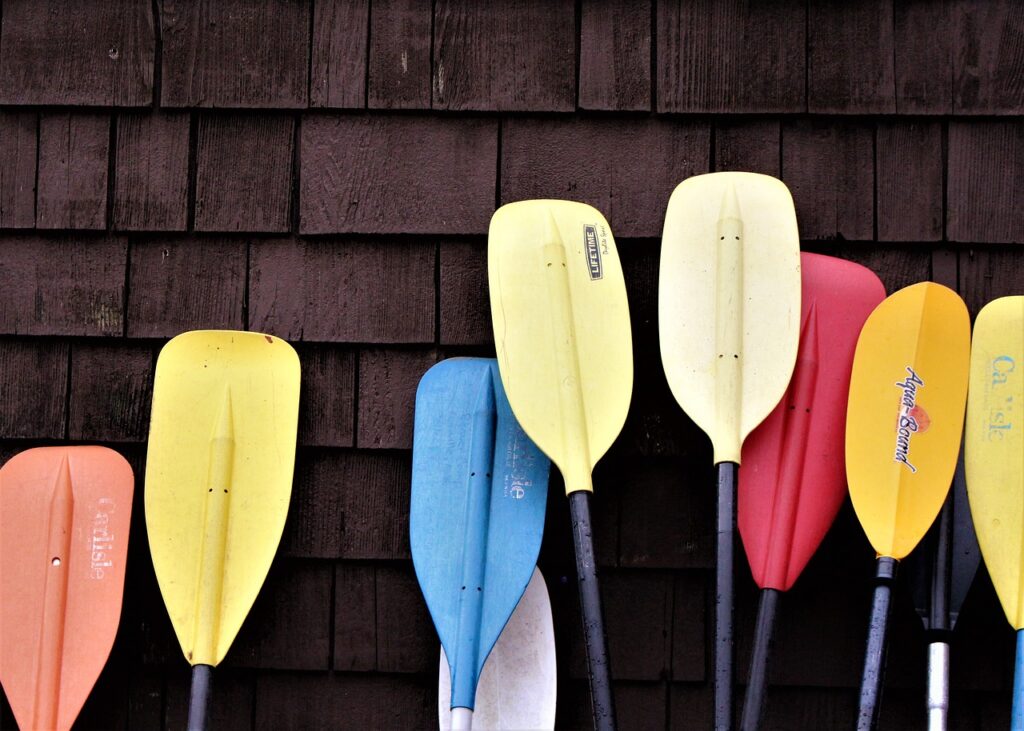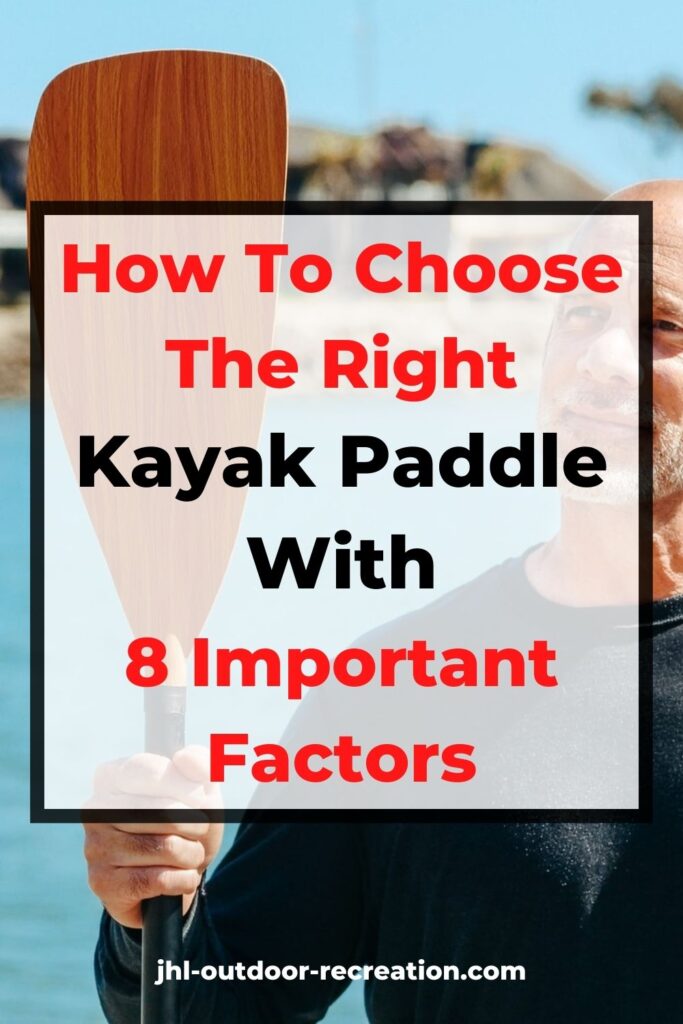When you buy grocery items, you cherry pick the items. You compare a lot of things. Price, brand, size, quality, etc. Literally you compare everything. Likewise, when you want to choose the right kayak paddle, you also need the same mindset.
You go to the kayak shop or surf the internet. There are TONNES of kayak paddle available. They are different to each other, in terms of size, brand, design, and the price surely.
Is it a good thing to you? Maybe yes and maybe no. – It is so overwhelming because you don’t know how to choose the right kayak paddle. How to choose?
Choosing the right kayak paddle is both art and science. There are a lot of thoughts needed before you reach your decision.
So, let’s look at the 8 important factors which help you choose the right kayak paddle.
1. Paddling style

Let’s put aside all the technical stuff about the kayak paddle first. Now, get to understand your paddling style before you choose the right kayak paddle.
Surprisingly, your paddling style places a great proportion when you decide the right kayak paddle. – And, we will cover this in the sections below.
Generally, there are two paddling styles, such as HIGH-ANGLE paddling and LOW-ANGLE paddling.
1.1 High-angle paddling
This is an AGGRESSIVE paddling style. In fact, you notice many athletes adopt this paddling style for racing and dynamic water kayaking. – In other words, this is a PERFORMANCE-BASED paddling style.
The paddlers immerse the blade close to the bow of the kayak. At the same time, the pulling arm is almost straight and around the shoulder level. The recovery arm, aka the pushing arm, is above the shoulder level.
Let’s imagine the paddling position as a triangle. You’ll notice the angle of the immersed blade is big and almost at a VERTICAL position.
1.2 Low-angle paddling
Conversely, this is a RELAXING paddling style. Many paddlers adopt this paddling style for RECREATIONAL and LONG-DISTANCE paddling.
The paddlers immerse the blade “far” from the bow of the kayak. Also, the pulling arm is dropped and below the shoulder level. The pushing arm is either below or at the shoulder level.
Thus, you’ll notice the angle of the immersed blade is small and at a HORIZONTAL position.
2. Purpose to choose the right kayak paddle
If we refer to the groceries buying above, do you agree that before we want to buy anything, we need to know WHY we need them? I hope you agree with this. – And this is exactly what we need before we buy anything!
Before you choose the right kayak paddle, let’s think of your PURPOSE of paddling. There are several questions you need to assess, though.
For example, do you need it for recreational purpose or whitewater kayaking, etc? And, I believe you realize different designs of kayak paddle cater for different occasions of kayaking.
What is the FREQUENCY of paddling that you anticipate? – Whether you mostly use the paddle for short or long kayaking session.
And don’t forget about the DURATION that you expect to use the paddle. Well, ask yourself whether you want to use it for 1 year or 5 years, for example.
If you plan to use for short period of time, you may focus on the PRICE. If otherwise, you may need to focus on the other factors.
3. Materials of paddle

There is a GOLDEN rule in paddling. The lighter the material of paddle is, the better the paddling performance is.
That is why you really need to pay attention to the materials of paddle because it directly influences the price of the paddle.
There are some common materials that are used for the SHAFTS and BLADES.
3.1 Aluminum
It is heavy. Because of this, aluminum paddle is an inefficient paddle and is horrible for performance-based paddling. – So, you rarely see the professional paddlers using aluminum paddles.
In fact, aluminum pedal is also inefficient for recreational paddling. This is because it makes the paddling getting tired much faster.
Due to the inherent weakness of aluminum paddle, it is usually CHEAP. You can consider buying an aluminum paddle if you plan on short and relaxing kayaking session.
Also, if you intend to use it as a temporary paddle, then this paddle is your choice. You can replace it anytime in future!
3.2 Plastic / nylon
Plastic is usually the material for the blade, but not the shaft. While plastic is light, it is relatively heavy if we consider other types of materials below.
Plastic blade is quite durable generally, so you don’t have to worry about maintenance or replacement. Though, it can crack due to aggressive usage of the paddle.
Because of its nature, we should avoid exposing the paddle under the sun.
Plastic blades are very flexible. But, don’t be confused by this. This is not a good feature for kayak paddles. A flexible blade reduces paddling efficiency, and hence weakens the paddling performance.
Thus, plastic blades are CHEAP. So, plastic blades are usually for recreational kayaking, but not for racing or whitewater kayaking.
3.3 Wood
Unlike other materials, wooden paddles can either be light or heavy. Generally, the wooden paddles are suitable for the common use.
But, it can also be expensive for those fancy wooden paddles. Some paddlers prefer wooden paddles as they view them as instruments or antiques. They believe wooden paddles have unique characteristic which other materials don’t have. – Sort of like wooden piano or violin.
Whether it is for fancy or common purpose, wooden paddles are seldom used for racing-based padding. – Simple. They are heavier than fiberglass and carbon fiber paddles.
3.4 Fiberglass
As the name suggests, fiberglass is where the sand is melted and used to create fiber.
Fiberglass paddle is very light and stiff. Stiffness is crucial for efficient paddling. The stiffer the paddle is, the lesser the energy is lost when paddling. Meaning, paddling is more efficient.
This is exactly the SWEET SPOT for kayak paddle. Hence, fiberglass is the most popular material for kayak paddle. If you want to find a kayak paddle which is cheap, light and durable, fiberglass kayak paddle is definitely the best choice!
Whether you are looking for a “recreational-type” paddle or “performance-based” paddle, you definitely can consider fiberglass paddle.
Although it is LIGHTER than aluminum and plastic paddles, it is HEAVIER than the carbon fiber paddle. – And this makes carbon fiber paddle superior!
3.5 Carbon / graphite fiber
Material for top-performing kayak paddle. Hands down!
Carbon fiber is a superior material for kayak paddle. It is ULTRA-LIGHT and ULTRA-STIFF. – These two are the PEFECT ingredients for racing- and performing-based like sprinting and whitewater kayaking.
Yes, carbon-fiber paddle is EXPENSIVE. Surprisingly, the material itself is common and not expensive. This is the same material as the lead of pencils.
So what makes carbon-fiber paddle expensive? – The technology and requirement that make carbon fiber.
The process of making carbon fiber is very technical and tedious. It requires a lot of machine power, as well as manpower, to create carbon fiber. And, the mistakes in the manufacturing process might be costly.
Price or quality. You really need to consider when you want to choose the right kayak paddle.
3.6 Kevlar
Bullet proof and armour material. Similar to carbon fiber, it is strong, light and great resistant to heat.
However, a pure Kevlar kayak paddle rarely exists. Rather, people use Kevlar to reinforce other materials, such as carbon fiber and fiber glass paddles.
This helps fine tune the stiffness and strength of the kayak paddle.
3.7 Synthetic
Synthetic refers to the combination of any materials in manufacturing the shafts and the blades. For example, you can find carbon fiber blades with wooden shaft.
Or, the material of the blade itself can consist of both fiberglass and carbon fiber.
Depend on the composition, synthetic materials have impact on the WEIGHT, STIFFNESS and the PRICE of kayak paddle.
4. Choose the right size of kayak paddle
This is exactly the same as buying the right size of the shoes. You hurt your toes if the shoes are too small; you cannot walk properly if the shoes are too big.
Likewise, choosing the right kayak paddle size is really important. This makes paddling more comfortable and efficient.
Long or short kayak paddle? How to decide? What kayak paddle size is suitable?
There are several ways to choose the right size of kayak paddle and they vary according to the factors below.
4.1 Height
The taller you are, the longer the paddle you need. There are 2 methods without measurement for your reference.
Method 1 – Hold the paddle in the right way. Your head should be at the centre of the shaft. Your elbows should form the right angles. The distance between the head and the hand should be around TWICE the distance between the hand and the end of shaft.
Method 2 – Stand straight and hold the paddle VERTICALLY next to you. Extend your hand to grab the TIP of the blade. If you are able to grab the tip with your first fingers joints, then that is the ideal length of the paddle.
4.2 Width
Actually, our height is just one of the factors when we choose the right kayak paddle size. To have a more accurate assessment, we need to consider the WIDTH of the kayak.
It is easy to understand. The wider the kayaker is, the longer the paddle needs to reach the water. – And we need measurement this round.
First, identify your height. Next, measure the size of the kayak. Then refer the chart and there you go. You can easily get the anticipated kayak paddle length.
Do note that the measurement varies accordingly depend on the source of provider. But, the good news is, the variation is usually very small and most of them provide consistent measurement to each other.
Let’s look at the chart from REI Co-op. For example, if you are 5’5 tall and the width of your kayak is 30 inches, the recommended length of the kayak paddle is 230cm.
However, this chart is for LOW-ANGLE paddling.
4.3 Others
The measurement of the length of kayak paddle becomes more complicated when you consider factors other than the height of paddler and the width of kayak.
But, the good news is, it further helps you to choose the right kayak paddle size when you consider the following factors:
4.3.1 Paddling style
For relaxing paddling style, ie. low-angle paddling, you need a longer paddle. This is due to the following reasons:
- longer size of blades (discussed in the section below)
- greater distance between the paddler and the blade in the water.
Likewise, for aggressive paddling style, ie. high-angle paddling, you need a shorter paddle. Although the chart from REI Co-op is for low-angle paddling, you can refer this as a starting point to reconsider the length accordingly.
4.3.2 Seating position of the kayak
This is for SIT-ON-TOP kayak if the seating position is high. The higher the position is, the further away from the water is. So, you need a longer kayak paddle.
5. Blade design of kayak paddle
Apart from the materials of paddle, you definitely need to pay attention to the design of the blade.
Why is it important? This is your main navigation tool. The blade design directly influences the paddling efficiency.
There are two factors you need to consider, such as the SHAPE and the SIZE of blades.
5.1 Shape

5.1.1 Symmetric vs asymmetric
As the name suggests, symmetrical blade means the upper blade shape and area are SYMMETRICAL to the lower blade’s. Likewise, asymmetrical blade means upper blade shape and area are greater than the lower blade’s.
So, why does it matter? Again, this has a close relationship with paddling style.
Symmetrical blade is suitable for high-angled paddling style. This makes the paddling EVEN on the blades. So, it enhances paddling efficiency.
Asymmetrical blade, however, is suitable for low-angled paddling style. As the blade is “perpendicular” to the water, this creates an uneven surface area for paddling for symmetrical blade. – This will greatly upset the paddling efficiency.
To counter this issue, asymmetrical blade is the alternate option. Furthermore, you’ll notice asymmetrical blades are wayyyyyyy more common than symmetrical blades.
5.1.2 Wing blade
A SPOON-LIKE blade specifically for kayak sprinting.
This design purely complements FORWARD stroke which it greatly increases the paddling power. – Only aggressive paddling style can reap the benefit of a wing-blade paddle.
Apart from aggressive paddling style, the paddler must possess great paddling skills, ie. full body rotation and powerful strokes. Otherwise, the paddler may find difficulty in navigating the kayak.
Furthermore, some paddlers find wing-blade paddle skew other strokes, such as reverse and sweep strokes, and the strokes look awkward. So, the paddlers may need to “modify” the way to execute the strokes.
5.1.3 Greenland blade
Unlike the standard shape of blade, Greenland blade is long and narrow. Also, the shaft is typically shorter that the shaft of the standard-shape blade.
Greenland blade is for long and relaxing paddling. The narrow blade greatly reduces the water resistance when paddling, hence it is very energy persevering. – You won’t feel tired easily when using Greenland blade.
Conversely, it is less efficient to move forward. So, paddlers naturally increase their cadence to counter this issue. – In fact, it is very similar to ride a bike with low gear.
If you want sea kayaking, then definitely you need to consider Greenland blade.
5.2 Size
There are two main sizes of blades.
Long and narrow – Again, this is suitable for low-angle paddling. The principle is similar to Greenland blade, as it is slow but energy saving.
Short and wide – This is for high-angle paddling. The great surface area of the blade allows catching more water, thus creates more powerful and faster paddling. The price is energy taxing, though. – You get tired easier when using this paddle.
6. Choose the right shaft of kayak paddle
Do you know that you also need to pay attention to the shaft when you want to choose the right kayak paddle? This is because it directly impacts your grip while paddling, which again influences paddling efficiency.
There are 3 factors about shaft that you need to consider. – Yeah, not 1, but 3.
6.1 Design
Straight shaft – Close your eye and imagine paddling on the lake. Then, look at the shaft of the paddle. I’m sure that the shaft that you are grabbing is STRAIGHT. – That’s right. That’s why straight shaft is so common……
It is a simple design and straight forward to use. But, there’s a catch. While we believe gripping the straight bar is natural, it actually strains our wrists.
And, this is why we have bent shaft.
Bent shaft – The shafts are bent at each side of the shaft. It looks like either a “V” or “W” shape. This is the area where you hold the shaft while paddling. – Of course, provided that you hold the paddle correctly.
The design of bent shaft is due to ERGONOMIC. This is a scientific way to allow our wrists in a neutral position while we’re paddling. Definitely, you find it more comfortable to hold the shaft this way.
This reduces the strain of our wrist and it effectively reduces the chance of wrist and arm fatigue or even injuries.
6.2 Diameter
The size of your PALM also determines the suitable diameter of the shaft. For example, if you have small palms, you should need a smaller diameter shaft.
You should genuinely feel comfortable when holding the paddle.
The difference might be subtle, especially if you just start paddling a few strokes at the very beginning. But, for long paddling session, you might find paddling exhausting and inefficient when you’re gripping the wrong-size shaft.
6.3 Ferrule
Most of the paddles come with ferrule-a part which allows the paddlers join the shafts or offset the angle of the paddle.
This also means paddlers can dismantle the shafts. So, they can carry and keep the paddle easily.
If keeping the paddle is your concern, you might need to look for the paddle with an “advanced” ferrule. – Some paddles can be split into 4 pieces, instead of 2.
7. Price

Alright, there you go with the factor that you are concerning the most!
The price of the paddle is determined by the features of the paddle above. Well, this is why I purposely put this after explaining all the factors above.
Essentially, high-performing paddles are expensive. Weight of the paddle is the main factor for a high-performing paddle. And, the materials greatly influence the weight of the paddle.
Because of that, a cheap kayak paddle can be less than $100; an expensive kayak paddle can be greater than $500.
So, does the price of the right kayak paddle match with your budget? If the price exceeds your budget, will you pay the premium to get a better quality kayak paddle?
8. Try the right kayak paddle
When you have an opportunity to try the kayak before you buy, don’t waste it! – This is a bonus!
Let’s test the so called right kayak paddle and see whether it is “right” for you. There’s no point where you get a perfect kayak paddle, and yet you don’t feel comfortable holding it.
Remember, everyone is unique. What is suitable for others might not be suitable for you. – After all, you want to find a kayak paddle which you are comfortable holding it.
Also, you can ask the experts at the kayak shop. No harm to ask. I’m pretty sure they are willing to help you choose the right kayak paddle!
Final thought: choose the right kayak paddle
To choose the right kayak paddle, rushing to buy a kayak paddle without any understanding is a big mistake.
When you wanna choose the right kayak paddle, take a step back and evaluate yourself first. What is my paddling style? What kayaking occasion do I want? ……
Get clear about yourself. Take some time to do research and understand the technical parts of a paddle. Of course, these include the shaft, blades, materials, etc.
Evaluation is critical. This helps you have a clear picture of a right kayak paddle. If the price is alright for you and you have tried the kayak paddle, then you genuinely choose the right kayak paddle!
Relevant posts
